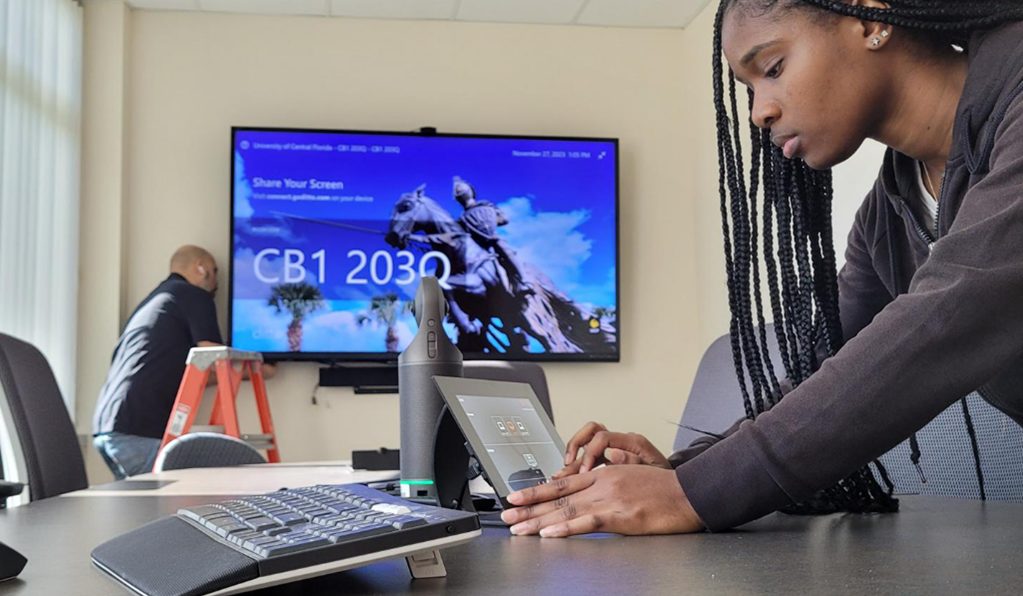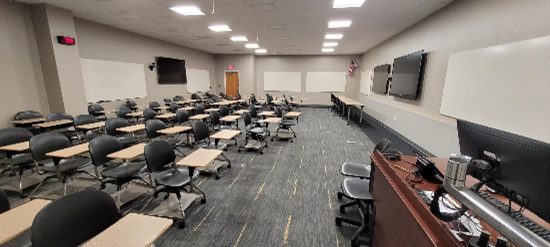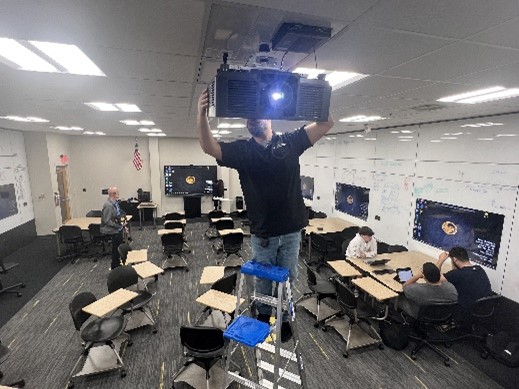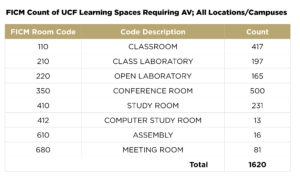
What is a classroom, and who supports it? One of our historical challenges in educational facilities to answering this question is a continuing failure to universally use the same definitions for “classroom” or “support staff.” Higher education audiovisual and information technology support teams have had a longstanding conversation regarding the appropriate ratio of support staff to classroom spaces. My first active role with the Educational Technology Collaborative (ETC) was on a 2015 task force studying the ratio of AV staffing and space support across our member institutions. But before we tackle the staff question, I’d like to address the issue of the “classroom” definition.
ETC members frequently reported that their faculty would say, “This is where my class meets, so it is a classroom.” While technically correct—wherever a class meets is the “class’s room”—that definition doesn’t serve us as well now as it once did. “Learning spaces” better describes where faculty hold courses even when the spaces no longer look like traditional classrooms, such as outdoor amphitheaters, art galleries, gross anatomy labs, or high-technology “active learning-enabled” spaces.
If the definition of a classroom can be messy within just one institution, imagine the challenge of getting faculty and facilities management leadership to agree on those terms across multiple institutions.
What’s in a name?
Another challenge is that our institutional space planning and facilities management partners—and their collaborating architects and designers—do not work within the same nuanced definitions as technology support teams tend to use. Look at blueprints for any new education building, and you may find buzzwordy descriptions like “collaboration space,” “ideation room,” or “hyflex learning space.” These terms are often based on how the planners and designers think about the space but do not always follow the use-case understanding we AV professionals have.
For instance, in one of our buildings at the University of Central Florida (UCF), there is a divisible room with a moveable partition designed as two independent AV systems, or, when opened, as a single, joined AV presentation space. That space walks, talks, and quacks like a divisible classroom but is listed as a conference room in our space inventory because academic conference meetings are held in it.

Image courtesy of UCF
A space’s use also changes after a building opens. In a twist on the saying, “No plan survives first contact with the enemy,” the saying might change to, “No space plan survives contact with its tenants.” No matter how well we survey faculty and students, they inevitably use space in ways we did not anticipate. This means how we eventually support the space is often disassociated from its original-drawing description. That nuance can be difficult to explain to our institutional peers, much less to compare with the space inventories at other institutions.
Developing an institutional standard
All these challenges only emphasize the need to find a common dataset to do better peer-to-peer comparisons. To move forward with our collective institutional reporting needs, we would all benefit by coalescing around shared definitions and leveraging existing data. The Postsecondary Education Facilities Inventory and Classification Manual (FICM – 4.3.1 Space Use Codes: Definitions, Descriptions, and Limitations (ed.gov) includes such data definitions and is published by the National Center for Education Statistics. The immediate benefit is that all postsecondary institutions already use the FICM for federal statistics reporting.

Image courtesy of UCF
Many facilities managers are familiar with these FICM definitions. For example, a “110 classroom,” depicting rooms or spaces that require no special equipment or configuration, is a term from these definitions. (There is someone at your institution who keeps these records. It may not be your registrar. It is more likely someone in facilities or space planning and management.) Unfortunately, these FICM definitions do not adequately capture purpose-built active learning spaces (e.g., Student-Centered Active Learning Environments [SCALE-UP], Technology Enabled Active Learning [TEAL], or “sandbox” classrooms), nor do they meet all our AV descriptor needs, but they do have consistent and historical data comparable across institutions—big and small, private and public.
The most significant advantage of using the FICM definitions is that it is no longer our understanding, or the understanding of our users, that drives the reporting. The FICM gives us concrete and institutionally vetted information on which to make plans and decisions. It also gives us comparable data for comparing our support footprint to our peers. And, for institutions with multiple AV or IT support units, it provides an internal, transferable metric to compare support footprints between teams.
Will this data always be correct? No. Does it completely describe all our spaces the way we would? No. However, it is the data the institution uses for federal reporting. Consistency—not driven by AV or any other technology in a given space—gives us all benchmarking capabilities with our peers. It also gives us independent data upon which to build tactical, strategic, and long-term planning. In times of tighter budgets, this is becoming ever more important.
How we apply FICM at UCF
Which space types/codes should we focus on for AV planning? I would suggest the following, using UCF’s numbers as reference:

At UCF, we’re using this FICM-based data to create a technology refresh plan to cover equipment in all classrooms and in other spaces as funding is available. The FICM data also gives our institution concrete numbers to focus on for budgeting and strategic planning. Tying the definitions to the refresh plan further encourages users to be more transparent in how they utilize assigned spaces.
At UCF we are also discussing how using the FICM standard with our space management group better reflects our tracking and reporting needs within these codes. One solution under consideration is appending decimal points (i.e., “.XX) to a space code to denote specific categories within that code. For instance, “110.01” represents a classroom with movable furniture.
Institutional comparisons of support and spaces are difficult because local space descriptions and definitions do not translate to other institutions. A national standard space definition lexicon does exist in FICM. We can all leverage it for inter-institutional comparisons and reporting. Although FICM definitions do not cover all our spaces’ definitions nuances (or politics), they do provide a foundation for building more accurate definitions and future reporting.
A collective opportunity
As a group, APPA facilities managers and ETC members can help by providing better collective data and feedback to the National Center for Education Statistics. Building a common-use database for all institutional facilities and technology management teams is a long-term effort and not an overnight solution to some of our issues. Still, I believe it is a necessary step.
While this approach does not solve our AV staff-to-space ratio question, it does get us closer to a unified data set upon which we can start to answer that question. Again, standardizing the FICM data definitions is a starting point, not a final solution. Until we compare apples to apples, however, we will continue to struggle to find the answers. As technology leaders on our campuses, we can work together to develop data sets to better tell the story of our needs and accomplishments.
To that end, ETC will conduct a 2024 industry-wide College & University Survey on Technology, where we will study space and support staffing and systems standards. If you are interested in participating, please drop me a line. Working with Craig Park, the Technology + Trends editor for this magazine, we will open the survey in 2024 and publish the results in a later column.
Don Merritt, PhD, is the director of instructional resources at the University of Central Florida and the immediate past president of the Educational Technology Collaborative. He can be reached at [email protected].
Technology + Trends
Seeks to identify technology and trends evolving and emerging in educational facilities. To contribute, please contact Craig Park, field editor of this column.
See all Technology + Trends.


